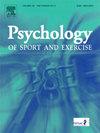学龄前儿童24小时运动行为和自我调节:使用成分和等时间分析的横断面关联。
IF 3.3
2区 心理学
Q2 HOSPITALITY, LEISURE, SPORT & TOURISM
引用次数: 0
摘要
幼儿期是大脑发育的关键时期,尤其是自我调节(SR),这对学业前的成功和社会情感能力至关重要。最近的研究强调了24小时运动行为(即体力活动(PA)、久坐行为(SB)和睡眠)在SR中的作用,但这些行为的构成与SR之间的关系尚不清楚。本研究旨在分析学龄前儿童24小时运动行为构成与认知行为SR的关系;并研究重新分配不同行为的时间时SR的预测变化。样本包括223名在巴西Petrolina公立幼儿教育中心注册的学龄前儿童(4-5岁)。运动行为采用加速度计评估,睡眠由家长报告评估,认知和行为SR分别采用早期工具箱和头,脚趾,膝盖,肩膀-修订测试进行测量。采用成分数据分析和等时数据分析分别考察了运动行为与SR和时间重新分配之间的关系。24小时运动行为构成预测了6%的视觉空间工作记忆和认知灵活性变异;将5、10或15分钟的睡眠时间和中高强度的日常活动重新分配给轻度的日常活动或日常活动与儿童的行为SR呈正相关,尽管在认知SR上没有发现关联。这些发现表明,低强度活动与儿童的行为SR之间可能存在积极的联系机制,应该在纵向和干预设计中进一步探索,旨在优化儿童早期的SR。本文章由计算机程序翻译,如有差异,请以英文原文为准。
24h movement behaviors and self-regulation in preschoolers: Cross-sectional associations using compositional and isotemporal analyses
Early childhood is a critical period for brain development, particularly in self-regulation (SR), which is essential for pre-academic success and socio-emotional competence. Recent studies highlight the role of 24-h movement behaviors (i.e., physical activity (PA), sedentary behavior (SB), and sleep) in SR. However, the relationship between the composition of these behaviors and SR remains unclear. This study aimed to analyze the association between the composition of 24-h movement behaviors and cognitive and behavioral SR in preschoolers; and to investigate predicted changes in SR when time in different behaviors is reallocated. The sample comprised 223 preschoolers (4–5 years-old) enrolled in public early childhood education centers in Petrolina, Brazil. Movement behaviors were assessed using accelerometry, sleep was evaluated by parent report, and cognitive and behavioral SR were measured using the Early Years Toolbox and the Head, Toes, Knees, Shoulders–Revised test, respectively. Compositional and isotemporal data analysis were used to examine the relationships between movement behaviors and SR, and time reallocations, respectively. The 24-h movement behaviors composition predicted 6 % of the variance in visuo-spatial working memory and cognitive flexibility; and 13 % in behavioral SR. Reallocating 5, 10 or 15 min from sleep and moderate-to-vigorous PA to light PA or SB was positively associated with behavioral SR, though no association has been seen on cognitive SR. These findings suggest a possible positive mechanism linking low-intense activities with children's behavioural SR, that should be further explored in longitudinal and interventional designs aimed at optimizing SR in early childhood.
求助全文
通过发布文献求助,成功后即可免费获取论文全文。
去求助
来源期刊
CiteScore
6.40
自引率
5.90%
发文量
172
审稿时长
69 days
期刊介绍:
Psychology of Sport and Exercise is an international forum for scholarly reports in the psychology of sport and exercise, broadly defined. The journal is open to the use of diverse methodological approaches. Manuscripts that will be considered for publication will present results from high quality empirical research, systematic reviews, meta-analyses, commentaries concerning already published PSE papers or topics of general interest for PSE readers, protocol papers for trials, and reports of professional practice (which will need to demonstrate academic rigour and go beyond mere description). The CONSORT guidelines consort-statement need to be followed for protocol papers for trials; authors should present a flow diagramme and attach with their cover letter the CONSORT checklist. For meta-analysis, the PRISMA prisma-statement guidelines should be followed; authors should present a flow diagramme and attach with their cover letter the PRISMA checklist. For systematic reviews it is recommended that the PRISMA guidelines are followed, although it is not compulsory. Authors interested in submitting replications of published studies need to contact the Editors-in-Chief before they start their replication. We are not interested in manuscripts that aim to test the psychometric properties of an existing scale from English to another language, unless new validation methods are used which address previously unanswered research questions.

 求助内容:
求助内容: 应助结果提醒方式:
应助结果提醒方式:


